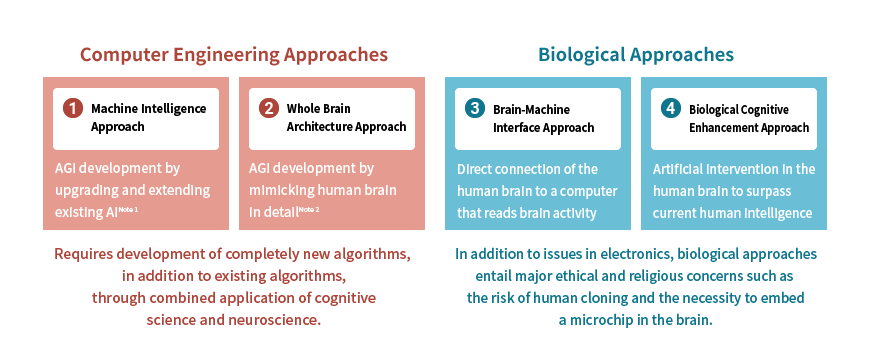
A world where AI provides humans with close support through super-human intellect
Combining Approaches to Expedite the Realization of Artificial General Intelligence
Advancements in Narrow AI Raise Hopes for the Realization of Artificial General Intelligence
In movies, futuristic robots are often portrayed as being able to think, act, and learn like humans. These robots come off as being human in nature because of their highly sophisticated artificial intelligence (AI) properties. Current forms of real AI are much more limited in their capabilities compared to the futuristic AI of cinema.
AI is broadly classified into two types: AI that is limited to one function, or narrow AI, and AI that performs various functions, or artificial general intelligence (AGI). The form of AI that is currently available is narrow AI, and AGI has yet to be realized. AI research began to take hold in the 1950s, and there have always been ideas similar to the concept of AGI such as the goal of developing a human-like robot. However, due to technical limitations, development has historically been focused on narrow AI.
Since entering the new millennium, advancements in computer devices have been accompanied by further acceleration in the development of narrow AI. During the process, a wide range of technologies that will provide the base for AGI have been developed at a high pace such as deep learning. Further, a deeper understanding of the human brain has also offered valuable insights for AGI research and development. Such progress has left many companies and research institutions with high hopes for the realization of AGI.
Concern on the Emergence of an Oligopoly on AGI Technology
A topic of constant concern in discussions surrounding the realization of AGI is the potential for AI to dominate human beings in the future. Advancement of the self-learning ability of AGI could lead to the achievement of the technological singularity (the singularity). The singularity refers to the point at which AI itself would begin to evolve autonomously. Achievement of the singularity would mean that AGI could exceed human capabilities, and there is already concern that robots could replace existing jobs and labor.
Kurzweil (2005)*1, an authority on AI research, speculates that the singularity with AGI will be achieved around 2045. However, opinions are split over the issue with a number of scientists skeptical toward forecasts for AGI to reach or exceed human intelligence by 2045.
Discussion is currently focused around the risk of an oligopoly on AGI technology. Regardless of whether or not AGI will cause the singularity, only a handful organizations will be able to develop AGI due to the highly sophisticated technologies required. In such a case, control of AGI technology will be limited to a select few platform businesses, resulting in a concentration of wealth and power greater than entire countries to those organizations.
Other concerns regarding AI that have spread both within Japan and around the world include the domination of humans by AI and the loss of human jobs to AI. In this context, discussion transcending geographical borders and individual businesses has begun and ranges from topics such as AI development policies, to AI ethics, and the relationship between AI and society.
Technological Breakthrough Requires Sharing of Knowledge
A greater degree of clarity has been gained on the technical challenges in developing AGI. There are four primary approaches in realizing AGI (Figure 1). All four approaches are underscored by the necessity for technological breakthroughs, such as deep learning for current AI, before AGI can be realized.
Four Primary Approaches to Realizing AGI

Note 2: Approach for developing and integrating each component of the brain (e.g. neocortex and hippocampus) as a machine learning module
Source: Mitsubishi Research Institute, Inc.
The Machine Intelligence Approach is an endeavor to develop AGI as an extension of current forms of narrow AI. The Whole Brain Architecture Approach aims to develop AGI by mimicking the human brain. Innovations in hardware and algorithms are indispensable to the realization of AGI through such computer engineering approaches.
The Brain-Machine Interface Approach aims to develop AGI by connecting the human brain to a computer to understand brain activity. The Biological Cognitive Enhancement Approach is an endeavor to intervene in the human brain to expand its functions. Understanding the structure of the brain is crucial for advancing such biological approaches, but brain functions have yet to see sufficient clarification.
While each approach offers great potential for realizing AGI, no single approach will do so in isolation or a linear manner. The combination of multiple approaches and more cohesive efforts toward AGI realization will prove to be the most efficient means to achieve the common goal. As such, groups conducting research on each approach must fortify their efforts to share knowledge with proponents of differing approaches. As has been the case with the development of space technology, AGI should be developed through international collaboration and as a technology shared by the world.
